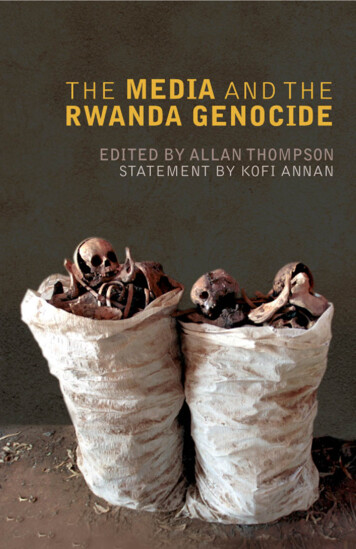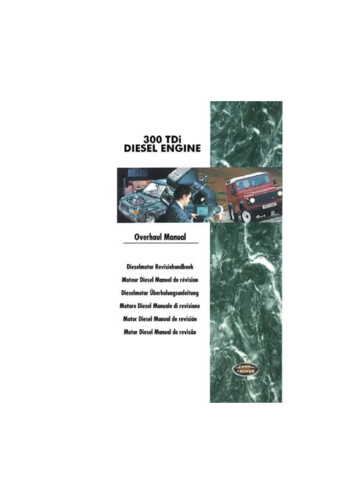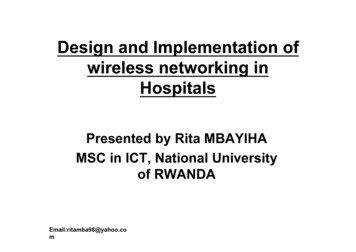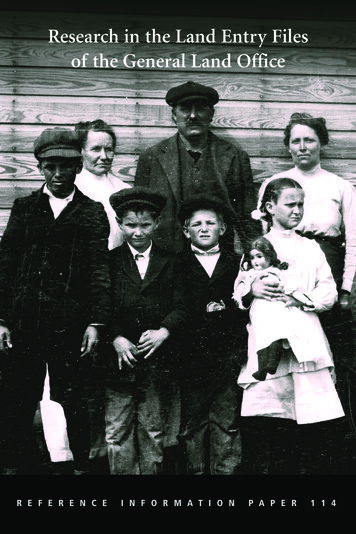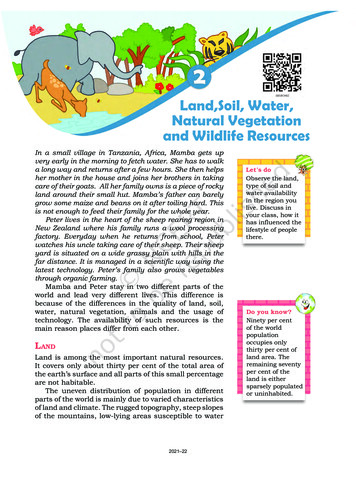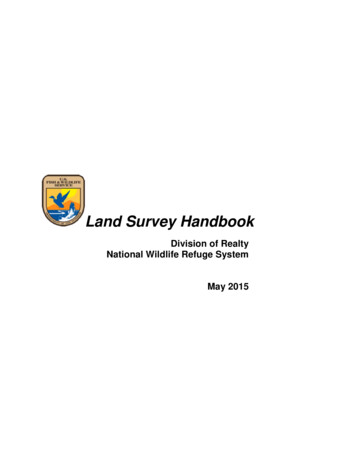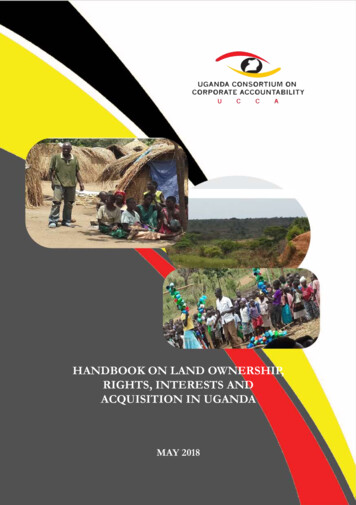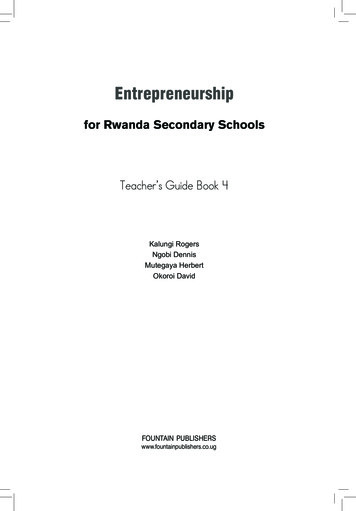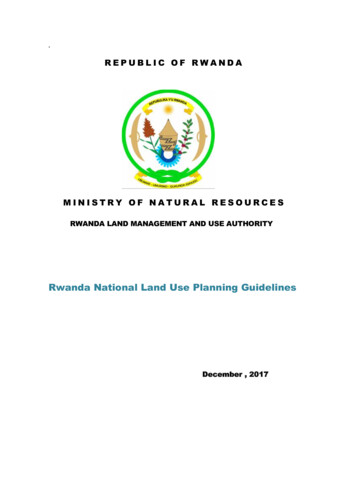
Transcription
.REPUBLIC OF RWANDAMINISTRY OF NATURAL RESOURCESRWANDA LAND MANAGEMENT AND USE AUTHORITYRwanda National Land Use Planning GuidelinesDecember , 2017
RWANDA NATIONAL LAND USE PLANNING GUIDELINESList of ContentsList of Contents.2List of abbreviations/Acronyms .7PREFACE .8EXECUTIVE SUMMARY . 10CHAPTER ONE:GENERAL CONTEXT . 121.0 Introduction . 121.1 Key Land Use Challenges and Threats . 131.2 Principles of National Land Use Planning Guidelines (NLUPG) . 151.3 Objectives of the National Land Use Planning Guidelines . 161.4 Aim of the Guidelines. 161.5 Purpose of the Guidelines. 161.6 Target users of the Guidelines . 17CHAPTER TWO: LEGISLATION AND POLICY INFORMANTS . 182.1. Land use planning guidelines in relation to legislation and policy informants . 182.2. Legal framework . 182.3. The Relationship between Guidelines and Vision 2020 Pillars . 182.4. The National Land Use Planning Guidelines in relation with EDPRS. 192.5. The 7 Year Government Program 2010-2017 . 192.6. National Land Use Planning Guidelines and the National Land Policy . 202.7. National Land Use Planning Guidelines and the Urban Planning and Building Code . 202.8. National Land Use Planning Guidelines in relation to Rwanda Green Growth and Climate ResilienceStrategy . 212.9. Guiding Principles for Sustainable Land Use Planning . 222.9.1. Household size. 222.9.2. Managing Population Density. 232.9.3. Urban Area Definition and Guidelines for District Urban Centres . 23 Definition . 23 Guidelines: . 232.9.4. Environment . 242.9.5. Densification . 252.9.5. Mixed Land Use . 252.9.6 Mixed Housing . 25CHAPTER THREE: LAND USE PLANNING PROCESSES GUIDELINES . 303.1. Land use planning definition . 303.3. Guidelines on the Land Use Planning Process and Steps . 303.4. Guidelines on Community and Stakeholder Collaboration in the Land use planning process . 343.4.1 Community and Stakeholder Participation. 343.4.2. Encourage Community and Stakeholder Collaboration in Development Decisions. 35Land Use Planning Guidelines2
RWANDA NATIONAL LAND USE PLANNING GUIDELINES3.4.3. Key strategies in this guide to achieving strong public support. 353.4.5. Public Sector Management/ Initiatives . 363.5. Guidelines on Environmental Assessment (EA) Integration in Land Use Planning . 363.5.1. General Environmental Considerations in Land Use Planning. 363.5.2. Strategic Environmental Assessment (SEA) in Land Use Planning. 37CHAPTER FOUR: MIX USE, DENSIFICATION AND ZONING URBAN LAND USES GUIDELINES . 384.1.Mixed Land Use Guiding Principles . 384.1.1. Definition . 384.1.2. Aims and Objectives . 394.1.3. Motivation for Mixed Use Development . 394.1.4. Different Combinations of Mixed Land Uses . 394.1.5. Need to Consider Requirements of Each Land Use . 404.1.6. “Overlay” Zoning – a Short Cut to Smart Green Growth Development. 404.1.6.1. Mixed (Income) Housing. 404.1.6.2. Motivation for Mixed Housing . 414.2.Densification Guidelines . 414.2.1. Definition . 414.2.2. Goal . 424.2.3. Objectives. 424.2.4. Densification Policy Statements . 434.2.5. Measures of densification. 444.2.6. Forms of densification. 454.2.7. Forms of densification in urban areas . 454.2.8. Forms of densification in rural areas . 454.2.9. Motivation for densification . 464.2.10.Generic considerations for urban densification. 474.2.11.Means of achieving densification . 484.3.Zoning Guidelines . 484.3.1. Definition . 484.3.2. Colour Coding in Zoning Land Uses . 484.3.3. Guidelines for Zoning Rural and Urban Development . 494.3.4. Guidelines for rural zoning areas . 494.3.5. Guidelines for Zoning of Urban Areas. 504.4.Guidelines for Land Sub-division, Consolidation and Replotting . 514.4.1. Definition . 514.4.2. Guidelines . 514.5.Guidelines for Land Use Change and Rezoning . 524.5.1. Introduction. 524.5.2. What is Rezoning?. 524.5.3. What is Change of Use? . 524.5.4. The Need to Rezone . 534.5.5. Who Initiates Rezoning?. 534.5.6. Period for Rezoning . 534.5.7. Persons Authorized to Prepare Rezoning Plans . 534.5.8. Conditions for Change of Use . 544.5.9. Procedure for Processing Rezoning Applications . 544.5.10.Procedure for Processing Change of Use . 544.6.Guidelines for Utility Corridors and Greenways. 55Land Use Planning Guidelines3
RWANDA NATIONAL LAND USE PLANNING GUIDELINES4.7.Guidelines for Parks and Recreation Areas . 554.7.1. Background and Definitions . 554.7.2. Guidelines on the public open and green spaces implementation . 574.8.Guidelines on sites and services . 584.8.1.Site development requirements . 584.8.2.Land subdivision requirements . 584.8.3.Neighborhood Safety. 594.8.4.Fire protection in human settlements . 594.8.5.Plot development requirements. 594.9.Guidelines for urban renewal . 594.10. Informal settlements upgrading . 604.10.1.Background and definition . 604.10.2.Physical Guidelines and Standards for Urban Upgrading and Renewal. 614.10.3.Minimum access to infrastructure and facilities for upgraded neighborhoods . 62CHAPTER FIVE: ENVIRONMENTAL AND SOCIO-ECONOMIC LAND USES GUIDELINES. 644.11. Guidelines for Industrial Location . 644.11.1.Definition. 644.11.2.Background . 644.11.3.Common Locational Requirements . 644.11.4.General Environmental Guidelines for Industry Location. 654.11.5.Buffer areas / Health protection zones standards . 664.12.Guidelines on preservation of agricultural and pastoral lands . 674.12.1.Background . 674.12.2.Guidelines on agricultural land . 674.12.3.Guidelines on urban agriculture . 694.12.4.Guidelines on peri-urban agriculture . 694.12.5.Guidelines on plantation farming/ estates. 694.12.6.Guidelines on livestock rearing. 704.12.7.Buffer areas in separating agricultural and residential land uses . 704.13.Guidelines on Agricultural, Industrial and Domestic Waste Management. 724.14.Guidelines on irrigation . 734.15. Guidelines on fish farming. 734.15.1.Background . 734.15.2.Location: . 744.15.3.Size and Shape. 744.15.4.Depth . 745.6.Guidelines for mining and quarrying . 745.6.1. Background . 745.6.2. Guidelines on Quarrying. 755.6.3. Guidelines on Mining . 755.6.4. Guidelines on mining (exploitation) . 75Land Use Planning Guidelines4
RWANDA NATIONAL LAND USE PLANNING GUIDELINES5.6.5.Guidelines on artisanal (small-scale) mining . 765.7.Guidelines on Establishment of Military Barracks, Camps, Garrisons, Trainings Institutions and otherInstallation. 765.8.Guidelines on Establishment of Refugees / Displaced Persons Camps. 76Background . 76The following are the guidelines: . 775.9.Guidelines on Hazards and Disaster Management . 775.9.1. Background . 775.9.2. Guidelines for flood-prone areas . 785.9.3. Guidelines for landslide-prone areas . 785.9.4. Guidelines on fire safety management . 785.9.5. Guidelines for Wind and earthquake prone areas. 795.10. Guidelines on the Protection of Ground water, Rivers, Lakes and Wetlands. 795.10.1.Guidelines for groundwater management . 795.10.2.Guidelines for rivers and lakes protection . 795.10.3.Guidelines for wetlands and wetland resources . 805.11.Guidelines on Protection of hilltops, hillsides, mountains and forests . 815.12.Guidelines on conservation of biological diversity. 825.13.Guidelines on protection of historic and cultural resources. 835.14.Guidelines on Transport and Information Communication Technology. 845.15.Land Use Planning Guidelines for airports and airstrips. 865.16.Land Use Guidelines for Setting up a Prison. 865.17. Guidelines for Establishment of Schools . 875.17.1.Planning Guidelines on Site Location of School Facilities. 875.17.2.Location of Schools – Planning Considerations . 885.17.3.General site location criteria . 885.17.4.Guidelines on Zoning for Education Facilities. 895.18. Guidelines for Establishment of Hospitals. 925.18.1.General requirements . 925.18.2.Site Location of Hospitals and Health Centres . 935.19. Guidelines for Hotel/Guesthouses and Resorts. 955.19.1.Site locations for hotels, guesthouses and resorts . 955.19.2.Planning and design standards . 965.20. Guidelines for Places of Worship/ Religious Facilities. 965.20.1.Definition. 965.20.2.Site and Location Requirements . 975.21.Planning Standards for Cemeteries . 995.22.Guidelines for Establishing Petrol Stations . 1015.23.Guidelines on the Conversion of Land . 1035.24.Guidelines on Land Recovery by the Government. 103CHAPTER SIX: ENVIRONMENTAL AND OTHER IMPACTS OF THE GUIDELINES. 1046.1.Introduction . 104Land Use Planning Guidelines5
RWANDA NATIONAL LAND USE PLANNING GUIDELINES6.2.Impacts on Transportation and Community Services. 1046.3.Impacts on the Regional and Community Structure . 1046.4.Impacts on Natural Resources and Ecological Conditions . 1056.5.Impacts on the Landscape, Town Image and Cultural Heritage . 1056.6.Impacts on People and Communities . 1056.7.Impacts on the Economy and Business Industry . 1066.8.Impacts on Planning and Decision-Making. 106CHAPTER SEVEN: LEGAL IMPLICATION, IMPLEMENTATION AND FOLLOW-UP OF THE GUIDELINES. 1077.1.Legal implications of the national land use planning guidelines. 1077.2.Land Use Planning . 1077.3.Activities of the Government Authorities . 1087.4.Follow-Up of the Implementation. 108Conclusion . 108References . 110APPENDIX I: Binding Directives for Land Use Changes of Areas and Hubs of National Interests till 2020(NLUDMP) . 112APPENDIX II: Directives for the Land Use Plan (LUP). 120APPENDIX III: Checklist for assessing compliance of an Local Urban Development Plan (LUDP) with the NLUDMPDirectives . 128APPENDIX IV: Flow Chart of Environmental Planning. 130Land Use Planning Guidelines6
RWANDA NATIONAL LAND USE PLANNING GUIDELINESL
NLUDMP: National Land Use and Development Master Plan NLUPG: National Land Use Planning Guidelines NGO’s: Non-Governmental Organizations OSC: Once Stop Centre RAB: Rwanda Agriculture Board RNRA: Rwanda Natural Resources Authority RLMUA: Rwanda Land Managemen
